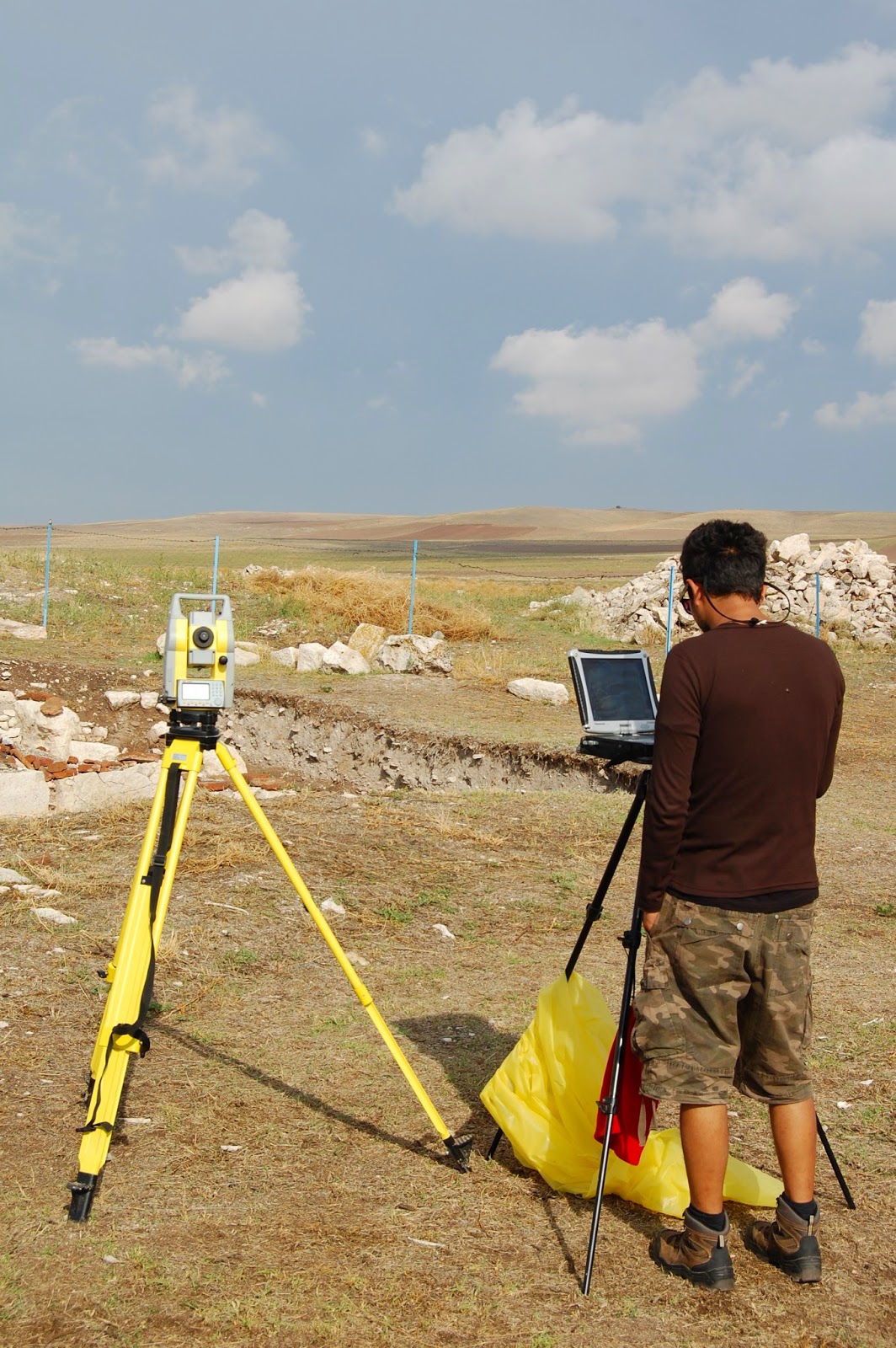Amorium 2014 excavation season is over, and so is our work at the Large Building trench. After the initial post-excavation "shock" it is time to take some initial glances back to the 2014 finds. The following small note does not cover the work conducted in the other trenches and depot research by our Director Zeliha Gökalp-Demirel and Assistant Director Ayse Ceren Erel who focused in other parts of Byzantine Amorium and mainly at the upper city where spectacular finds are being made.
The excavation at the Large Building in particular is part of a wider project aiming to understand Early and Middle Byzantine civic and residential functions in the lower city of Amorium (actually its west part, marked red in the following topographical map), and to track the evolution of urbanism and city planning from Late Roman to Byzantine Early Medieval and Middle Byzantine times.
 |
| Amorium topographical plan (© Amorium Kazı/Amorium Excavations) |
This year we opted for excavating an area just 20 m. east of the old Large Building characterized by extensive surface remains of masonry and wall cores. The surface remains implied the existence of four massive piers, roughly triangular in shape and in a regular relationship between them. They seemed to be framing a square area approximately 15X15 m and following the axis of the uncovered parts of the Large Building. The actual visible on the surface elements proved to be the core of each of these piers created in opus caementicium and preserved in different heights. These elements were already easily visible in satellite imagery as you can see in the following picture at the upper right.
 |
| Large Building, Amorium, satellite imagery. On the right above the cultivated field the four piers as seen on the surface (© Amorium Kazı/Amorium Excavations) |
During the excavation one of the four piers was partially unearthed, and although very early in the process of uncovering this special building some initial characteristics can be noted. The pier is of general triangular or even rectangular shape with one corner pointing to the center. Its core is constructed with layers upon layers of Roman cement filled with medium stones and bricks. Its side surfaces would have been covered with ashlar stone and brick layers, as we encountered is some better preserved parts. The floor of the building lays at least two more meters further below the level reached. The single massive pier excavated seems to be shaped all around in a series of niches and recesses, with arches and vaults springing from it.
 |
| Excavated pier at the Large Building, Amorium (© Amorium Kazı/Amorium Excavations) |
It would be reasonable to suppose that the other three piers would also repeat more or less the same shape and plan in a canonical arrangement. In this case a central area would be framed all around by a sequence of rectangular and semi-circular recesses roofed with a dome or a tower dome. Though it is still very early it seems plausible to suggest that this new Amorium centrally planned building would resemble in ground-plan, although in smaller proportions, other known monuments from Asia Minor, like the baptistery of Saint Mary in Ephesus.
At the end of the season we had the opportunity to work on digitizing our plans with a specialized team of archaeologists and topographers from Anadolu University, under the direction of Seçkin Evcim. Using high technology we plotted in the site canvas, digitally planned the new finds and scanned the Large Building area, in order to better understand what is going on.
 |
| Plotting the Large Building at Amorium (© Amorium Kazı/Amorium Excavations) |
So, this is it for Amorium Urban Archaeology side-project 2014 fieldwork, now there is a lot of work to be done at the lab and the library. As the initial finds show we are truly excited and cannot wait for the forthcoming 2015 season.
Finally a great thanks to all the participants in this year's Large Building team. Our excavation team this year under the guidance of Nikos Tsivikis, consisted of archaeology assistants: Selda Uygun and Görkem Işık, and archaeology students: Sevinç Özen, Burcu Tutar, Ceren Uzun, Serhat Akoğlu, Oğulcan Avcı, Arda Güldoğan and Ahmet Levent-Zeybek.
For those of you that want to dig deeper in the archaeology of Amorium's Large Building area and our new and exciting side-project here is some further reading:
R. M. Harrison, Amorium 1988: The First Preliminary Excavation, Anatolian Studies 39(1989), 167-174. [link]
R.M. Harrison et al., Amorium Excavations 1989, the Second Preliminary Report, Anatolian Studies 40 (1990), 205-18. [link]
C. Lightfoot, N. Tsivikis, and J. Foley, “Amorium Kazıları 2009,” 32. Kazı Sonuçları Toplantısı, cilt 1, Istanbul, 24-28 Mayıs 2010, Ankara 2011, 47-68. [link]
J.C. Donati and N. Tsivikis, "When you look from high up… a Middle Byzantine provincial capital: archaeology and satellite research at Amorium in Asia Minor,” στο: 34ο Συμπόσιο Βυζαντινής και Μεταβυζαντινής Αρχαιολογίας και Τέχνης, ΧΑΕ-Περιλήψεις, Αθήνα 2014, 126-127. [link]
No comments:
Post a Comment